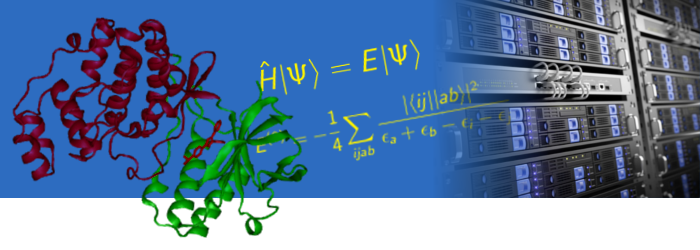Theoretical and computational chemistry play a critical role in modern chemistry. Computational chemistry at UCR ranges from high-quality ab initio quantum chemistry calculations on molecules, surfaces, and in molecular crystals to molecular dynamics simulations of host-guest interactions and of large biomolecular simulations on systems containing tens of thousands of atoms. Our researchers use computational tools to interpet experiments, to understand chemical and biological mechanism at the atomic scale, and to make predictions that guide future experiments. Sometimes existing theoretical tools and software packages are sufficient for these studies. More often, however, we need to develop new conceptual frameworks, algorithms, and software to address current problems.
In addition to our research groups that focus entirely on theoretical chemistry, several of our experimental groups make extensive use of computational chemistry.
Theoretical & computational chemistry research groups:
Gregory Beran
Quantum chemistry in liquids and solids: The Beran group uses computational quantum chemistry to predict chemical behavior in the gas and condensed phases. Recent work has focused on predicting molecular crystal structures and properties, mechanisms in heterogenous catalysis, and the interpretation of various spectroscopic experiments. We develop the new theoretical algorithms that make high-quality and robust predictions feasible in these complex systems.
Chia-en Chang
Molecular dynamics in chemical and biological systems: The Chang group primarily uses classical molecular mechanics to investigate the chemistry of chemical and biological systems . We wish to understand how molecules can bind and how molecular flexibility influences ligand binding, and use the knowledge to design molecules and interpret experiments. Applications involve investigations of protein function, in silico drug design, and the manner in which host-guest molecules come together. We have developed new methods to understand the long time- and length-scales of the ligand binding kinetics.
Experimental groups that make extensive use of theory:
A large fraction of the research groups in our department use computational chemistry tools or collaborate with theoretical chemists. The following experimental groups, however, make particularly extensive use of theoretical modeling and have some group members who devote a significant fraction of their research effort toward theoretical modeling.
Ludwig Bartels
The Bartels group models the stability, adsorption and dynamic behavior of 2D materials (such as MoS2) and molecular adsorbates at metal surfaces (e.g. dithioanthracene on Cu) using density functional theory codes. We operate our own computational cluster with about 150 processors. Most commonly, we use VASP as DFT code, which allows modeling of solids and surfaces using periodic boundary conditions. Developing scripts to model dynamic behavior and gain chemical insight into surface reactions is at the center of our computational activity.
Boniface Fokwa
The Fokwa research group is interested in novel inorganic solids derived from the combination of main group elements and metals (mainly transition metals). Much emphasis lies on the elucidation of the crystal and electronic structures as well as structure-bonding-property correlations of such new compounds, thus enabling their potential applications as materials for energy related technologies (magnetic, magnetocaloric, superconducting and spintronic materials) as well as refractory materials (hard and superhard materials) and catalysts.
Ryan Julian
Mass spectrometry, spectroscopy, molecular dynamics, and ab initio calculations are used to examine the sequence, structure, and modification of biomolecules with an emphasis on proteins and peptides. Radical chemistry, supramolecular chemistry, ion-molecule reactions, photodissociation, and collisional activation are frequently employed in these experiments. The primary focus is to obtain a molecular level understanding of chemistry related to life.
Leonard Mueller
Solid-state NMR in enzymes: The Mueller group is developing NMR crystallography - the synergistic combination of solid-state NMR and X-ray crystallography - to investigate enzyme catalytic mechanism at a new level of atomic detail. Tying these techniques together is computational chemistry (quantum and mixed quantum/classical calculations), which allows specific models of the chemical structure to be built upon the coarse X-ray framework and then tested by a comparison of predicted (ab initio) and assigned chemical shifts. The result is a unique and chemically-rich molecular view into functioning enzyme catalysis.
Bryan M. Wong
The Wong group develops and applies first-principles, quantum-mechanical computational techniques to predict, understand, and rationally design chemical/material systems (either previously synthesized or yet to be made). Our motivation arises from a deep interest in electron dynamics – a surprisingly rich research area that centers on the non-equilibrium (i.e., time-dependent) electronic properties of systems. Our expertise in developing and applying new electronic structure and time-dependent dynamics techniques brings a new, unique capability for exploring these rich, emerging areas in complex chemical/material systems.

